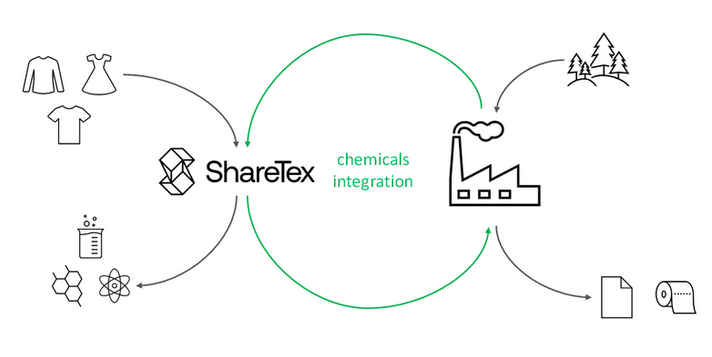ShareTex has developed a versatile process to recycle (cellulose-based) waste textiles into new raw materials for the industry. This process targets several products so that waste textiles can be recycled regardless of their properties, imposing minimal or no requirements on the starting material. The reason for this is that waste textiles are a mixture of very different materials. For example, cotton fibers have one of the longest cellulose polymers and crystallinity in nature while man-made cellulose fibers, such as viscose or lyocell, have much shorter and less crystalline polymers. The fractions with cellulose polymers in good condition are transformed into a cellulose pulp, which can be used for the production of new textiles, while the fractions that cannot be converted into new textiles are transformed instead into a glucose solution, which can be used in the production of green chemicals. Thanks to this versatility, the process creates a cascading effect in which the value of the material can be recovered at the highest value possible depending on the properties of the cellulose polymer. In this way, ShareTex can offer valorization alternatives for the entirety of this waste stream and introduces an additional step after textile-to-textile recycling in the waste hierarchy, called end-of-life valorization, which minimizes the flow of waste textiles to incineration and/or landfill.
The cellulose pulp process consists in exposing waste textiles to a solvent that can only dissolve cellulose at certain concentrations. Thus, by simply diluting the system after dissolution has been completed, the material is precipitated in the form of a cellulose pulp. The fibers in the cellulose pulp remain intact and without any significant damages so that the quality of the material can be mantained throughout the recycling process.
The glucose process consists in depolymerizing waste textiles to their smallest unit, the sugar molecule called glucose. This sugar is one of the biggest industrial feedstocks in the chemical industry and can be used as a starting material in the production of plastics, cosmetics, pharmaceuticals, etc. In fact, some of the molecules that can be produced from glucose can be used as precusors in the production of synthetic textile fibers so even this route offers the possibility to bring the value of the material back to the textile industry, in the form of recycled and biobased synthetic fibers.

